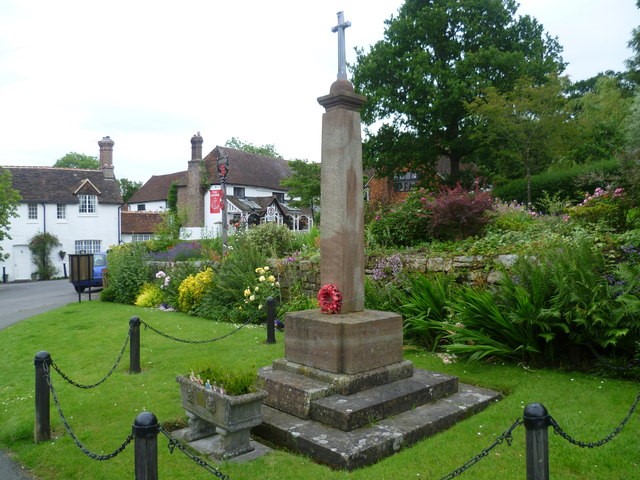GEORGE MASKELL
Private, G/5679, 9th Battalion, Royal Sussex Regiment
Killed in Action, Battle of Loos, Pas de Calais, France on 25 September 1915, aged c.33
Commemorated on the Loos Memorial: Panel 71

Hartfield War Memorial
(Click to enlarge)
George Maskell was born in Heathfield in the civil parish of Mayfield in 1882. His parents, Henry and Naomi Maskell (née Braban), had married in Burwash in 1880, and already had a son, Leonard. George was the second child of an eventual family of thirteen. In 1891 the family was at Colkings Mill in Mayfield. By 1901 they had moved to Butcherfield Cottages in Hartfield, but George was working as a farm labourer at Ardingly. In 1911, aged 27, George was back at home, and still unmarried, but now working as a miller, and enumerated at Butcherfield Cottages as a grinder at mill.
He enlisted in Tunbridge Wells with the Royal Sussex Regiment, part of the British Expeditionary Force which landed in France in August 1914. Presumably he fought with his regiment in the First Battle of Ypres in November 1914, and at Mons, the Marne, the Aisne and Aubers Ridge. Although he is recorded as killed in action — on 25 September 1915 in the Battle of Loos, Pas de Calais, France — the UK Army Registers of Soldiers' Effects notes under Date and Place of Death:
on or since 25/28. 9. 15. Death presumed.
He was listed as 'Missing' on the Casualty Lists issued by the War Office from 3 November 1915.
The Soldiers' Effects document shows his mother Naomi as sole legatee, and the authorisation of payments of small amounts (less than £5 in total) to her in 1917, 1919 and 1920.
As no body was ever recovered, there is no grave. Instead, George is recorded on the Loos Memorial, and also on the war memorial at Hartfield. His brother Mark was killed in action on the Somme a few months later on 10 November 1916.
The lead up to the Battle of Loos is recorded in the Royal Sussex Regimental Diary. The men were on the move or in billets until 23 September, then in bivouacs and finally in trenches at Vermelles to prepare for battle. The diary shows the battalion to have been near Hulluch where it took up position in the support line at 1.50 a.m. At 6.30 a.m., they moved into a front line trench. The British had used gas, but a change in wind direction blew some of it back into their own trenches. The advance which followed enabled many men to reach the German wire, but it had not been cut. It seems likely, given that the authorities were unsure of George's date of death, that he was one of the many men either wounded or killed at the wire.
In writing about the death of his brother Mark in December 1916, the Kent and Sussex Courier noted that George had been reported missing. A further article in the same paper on 26 October 1917 was written about George's brother Harry, in hospital in Orpington after breaking a leg and having an arm amputated. The paragraph concludes:
He is the seventh son of Mrs Maskell in His Majesty's Forces. Two of his brothers — George and Mark — have been killed.
In October 1920, The Kent and Sussex Courier published a piece on the unveiling of Hartfield War Memorial, attended by a large crowd of parishioners. It described the Derby stone memorial as imposing, and said it had been placed:
close to the Elm tree in the centre of the village
One of the names in the following list was that of Pte G. Maskell.

Inscription of Pte G. Maskell on Hartfield War Memorial
(Click to enlarge)
Pam Griffiths
7 September 2015
Updated 28 October 2019 & 9 January 2022
Note
Five sons of Henry and Naomi Maskell have been proven to have served in the First World War, of whom two — George Maskell and Mark Maskell — were killed in action while three are known to have survived. A second cousin, Harry George Maskell, who is also commemorated on Hartfield War Memorial, also fell in the war. Click here to see a family tree of these two branches of the Maskell family.
Source
Hartfield War Memorial photograph © Marathon. Licensed for reuse under the Creative Commons Licence.

